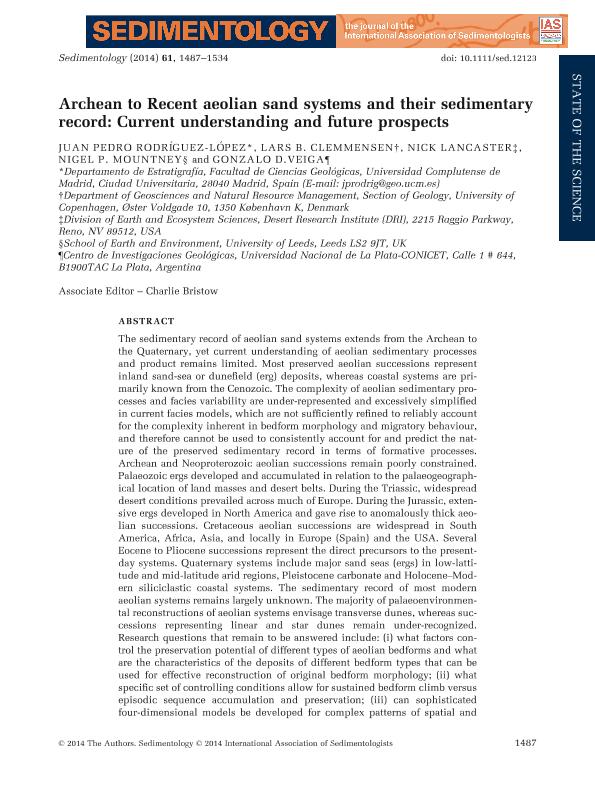Artículo
Archean to Recent aeolian sand systems and their sedimentary record: Current understanding and future prospects
Rodríguez López, Juan Pedro; Clemmensen, Lars B.; Lancaster, Nick; Mountney, Nigel P.; Veiga, Gonzalo Diego

Fecha de publicación:
09/2014
Editorial:
Wiley
Revista:
Sedimentology
ISSN:
0037-0746
Idioma:
Inglés
Tipo de recurso:
Artículo publicado
Clasificación temática:
Resumen
The sedimentary record of aeolian sand systems extends from the Archean to the Quaternary, yet current understanding of aeolian sedimentary processes and product remains limited. Most preserved aeolian successions represent inland sand-sea or dunefield (erg) deposits, whereas coastal systems are primarily known from the Cenozoic. The complexity of aeolian sedimentary processes and facies variability are under-represented and excessively simplified in current facies models, which are not sufficiently refined to reliably account for the complexity inherent in bedform morphology and migratory behaviour, and therefore cannot be used to consistently account for and predict the nature of the preserved sedimentary record in terms of formative processes. Archean and Neoproterozoic aeolian successions remain poorly constrained. Palaeozoic ergs developed and accumulated in relation to the palaeogeographical location of land masses and desert belts. During the Triassic, widespread desert conditions prevailed across much of Europe. During the Jurassic, extensive ergs developed in North America and gave rise to anomalously thick aeolian successions. Cretaceous aeolian successions are widespread in South America, Africa, Asia, and locally in Europe (Spain) and the USA. Several Eocene to Pliocene successions represent the direct precursors to the present-day systems. Quaternary systems include major sand seas (ergs) in low-lattitude and mid-latitude arid regions, Pleistocene carbonate and Holocene–Modern siliciclastic coastal systems. The sedimentary record of most modern aeolian systems remains largely unknown. The majority of palaeoenvironmental reconstructions of aeolian systems envisage transverse dunes, whereas successions representing linear and star dunes remain under-recognized. Research questions that remain to be answered include: (i) what factors control the preservation potential of different types of aeolian bedforms and what are the characteristics of the deposits of different bedform types that can be used for effective reconstruction of original bedform morphology; (ii) what specific set of controlling conditions allow for sustained bedform climb versus episodic sequence accumulation and preservation; (iii) can sophisticated four-dimensional models be developed for complex patterns of spatial and temporal transition between different mechanisms of accumulation and preservation; and (iv) is it reasonable to assume that the deposits of preserved aeolian successions necessarily represent an unbiased record of the conditions that prevailed during episodes of Earth history when large-scale aeolian systems were active, or has the evidence to support the existence of other major desert basins been lost for many periods throughout Earth history?
Palabras clave:
Sedimentologia
,
Sistemas Eolicos
Archivos asociados
Licencia
Identificadores
Colecciones
Articulos(CIG)
Articulos de CENTRO DE INVEST.GEOLOGICAS (I)
Articulos de CENTRO DE INVEST.GEOLOGICAS (I)
Citación
Rodríguez López, Juan Pedro; Clemmensen, Lars B.; Lancaster, Nick; Mountney, Nigel P.; Veiga, Gonzalo Diego; Archean to Recent aeolian sand systems and their sedimentary record: Current understanding and future prospects; Wiley; Sedimentology; 61; 6; 9-2014; 1487-1534
Compartir
Altmétricas



